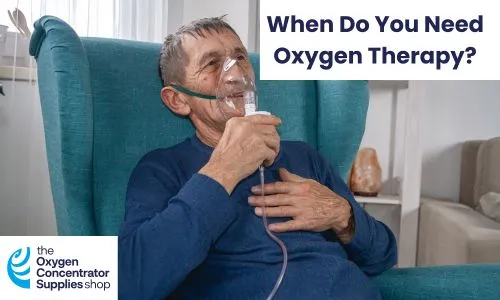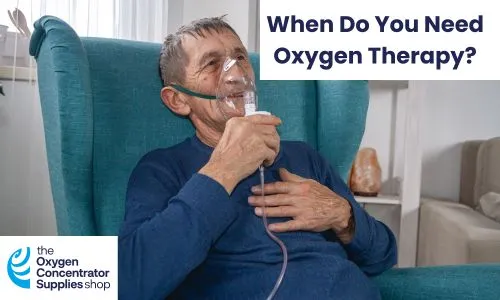

Oxygen is a necessity for human life. Our lungs and only our lungs can draw in breath and deliver oxygen into the body. The heart pumps red blood cells into the lung. Here, the red blood cells are refreshed with oxygen. They are then sent through the major blood vessels to all the body’s tissue and organs, including the brain, heart, and skeletal muscles. And, all of this happens without us even noticing! This continuous process keeps us alive and active. If this process fails, we need oxygen therapy.
At sea level, air is made up of 21% oxygen and 79% other gases (ie, nitrogen, carbon dioxide, and air pollutants). The concentration of oxygen is lower at higher altitudes. At 5000 feet, the air has approximately 17% oxygen. At 8000 feet, oxygen drops to 15%. For reference, Lake Tahoe in California is 6232 above sea level.
When is oxygen therapy needed?
At times, such as during exercise, the demand for oxygen exceeds the existing supply in the body. In these cases, the person either needs to stop the exercise or increase the blood oxygen supply by recruiting the lung tissue surface area to extract more oxygen. When this does not happen, the blood levels of oxygen can fall below normal. This is called hypoxemia. Hypoxemia is treatable with oxygen therapy, otherwise known as supplemental oxygen.
Hypoxemia or abnormally low arterial blood oxygen levels in blood is defined by pulse oximetry reading of less than 88%. This is considered the very lower limit of normal.
People and patient may perceive hypoxemia by becoming short of breath with exercise and/or being less alert or cognitive. I remember professional American football running back Emmitt Smith of the Dallas Cowboys breathing oxygen on the sidelines after running for a touchdown against the San Francisco 49ers. Why? So that he can restore his body’s oxygen supply and run for another touchdown!
What does it feel like when you do not receive enough oxygen?
Without enough oxygen, our body’s skeletal muscles would tire easily from physical exercise and we would feel fatigued. The lungs are also dependent on oxygen and feed via the bronchial arteries. Finally, the brain and heart are particularly at risk of injury from prolonged hypoxemia if both the level and duration of oxygen starvation become extreme.
Sudden lower-than-normal oxygen levels in the blood or acute hypoxemia can lower the level of alertness, cause distress breathing, more rapid breathing, shortness of breath, muscle fatigue, and even chest pains. This is a serious condition and can occur in anyone with acute pneumonia, a pulmonary embolus or blood clot to the lungs, asthma attack, or COPD exacerbation.
How do you treat hypoxemia?
The only way to treat acute hypoxemia immediately is with extra or supplemental oxygen. Begin at a dose of 2 liters per minute (LPM) and keep giving until the patient returns to a normal state without hypoxemia. Many children and adults need supplemental oxygen for a short period of time to several weeks if they were previously hospitalized and discharged for severe asthma or acute pneumonia. The physician will try to keep your oxygen level your blood >60 mmHg.
What is chronic hypoxemia?
Chronic hypoxemia is longstanding low levels of oxygen in blood. This condition was untreated before the 1980s. In many patients, chronic hypoxemia causes a bluish tint, particularly on the lips and fingertips. In fact, people with COPD were once called “blue bloaters” because of their appearance due to hypoxemia. Chronic hypoxemia can occur in patients with COPD, sleep apnea, pulmonary fibrosis, bronchiectasis, cystic fibrosis, pulmonary arterial hypertension, congenital heart disease, chronic heart failure, chronic pneumonia to only name a few.
In most cases, extra oxygen or supplemental oxygen might improve symptoms and longevity. Raising the concentration of oxygen above 21% in a breath helps COPD patients live longer. They also enjoy a better quality of life, including physical and social activity and sleep.
Together with your physician or provider, you can determine if you need supplemental oxygen and oxygen equipment.
Note: Medicare very tightly regulates the prescription of oxygen and especially long-term oxygen therapy (LTOT) in the United States. Hypoxemia alone is not covered by Medicare. There must be an underlying medical condition causing hypoxemia for oxygen therapy to be covered.
Is supplemental oxygen therapy needed in COPD?
The prevalence of hypoxemia among COPD patients is uncertain. In large, general COPD populations, severe hypoxemia is relatively uncommon. In the UPLIFT trial, only 2% of the 5993 participants were prescribed supplemental oxygen.1
Once COPD is diagnosed, physicians turn to pharmacological interventions as the first-line of treatment. Oxygen therapy is often overlooked. However, hypoxemia associated with COPD reduces quality of life, diminishes exercise tolerance, reduces skeletal muscle function, and ultimately, increases risk of death. Using long-term oxygen therapy to treat severe hypoxemia is one of the few interventions that is proven to prolong life in hypoxemic COPD patients.3
References:
- Tashkin DP, Celli B, Senn S, et al. A 4-year trial of tiotropium in chronic obstructive pulmonary disease. N Engl J Med. 2008 Oct;359(15):1543-54.
- Garcia-Aymerich JG, Lange P, Benet M. Regular physical activity reduces hospital admission and mortality in chronic obstructive pulmonary disease: a population-based cohort study. Thorax. 2006 Sep;61(9):772-8.
- Kim V, Benditt JO, Wise RA, Sharafkhaneh A. Oxygen therapy in chronic obstructive pulmonary disease. Proc Am Thorac Soc. 2008 May;5(4):513-18.
This post was originally published on July 3, 2019, and updated on August 25, 2023.



